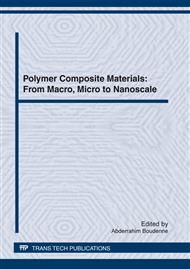[1]
Ko, F. K., Gogotsi, Y., Ali, A., Naguib, N., Ye, H., Yang, G., Li, C. and Willis, P. Electrospinning of continuous Carbon Nanotube-Filled Nanofiber Yarns, Adv. Materials, 2003, 15, 1161.
DOI: 10.1002/adma.200304955
Google Scholar
[2]
Ye, H., Lam, H., Titchenal, N., Gogotsi, Y., and Ko, F., Reinforcement and rupture behaviour of carbon nanotubes-polymer, Appl. Phys. Letters, 2004, 85, 1775.
DOI: 10.1063/1.1787892
Google Scholar
[3]
Xie, X. L., Mai, Y. W. and Zhou, X. P., Dispersion and alignment of carbon nanotubes in polymer matrix: A review, Material science and Engineering R , 2005, 49, 89.
Google Scholar
[4]
Huang, Z. M., Zhang, Y. Z., Kotaki, M. and Ramakrishna, S., A review on polymer nanofibers by electrospinning and their applications in nanocomposites, Composites Sciences. and Technology, 2003, 63, 2223.
DOI: 10.1016/s0266-3538(03)00178-7
Google Scholar
[5]
Kim, G. H. Electrospinning processing field-controllable electrode, J. of Polymer Science: Part B: Polymer Physics, 2006, 44, 1426.
Google Scholar
[6]
Dror, Y., Salalha, W., Khalfin, R. L. Cohen, Y. Yarin, A. L. and Zussman, E.,. Carbon nanotubes embedded in oriented polymer nanofibers by electrospinning, Langmuir, 2003, 19, 7012.
DOI: 10.1021/la034234i
Google Scholar
[7]
Gates, T. S., Odegard, G. M., Frankland, S. J. V. and Clancy, T. C., Computational materials: Multi-scale modeling and simulation of nanostructured materials, Composite Science and Technology, 2005, 65, 2416.
DOI: 10.1016/j.compscitech.2005.06.009
Google Scholar
[8]
Gao, X. L., Li, K., A shear-lag model for carbon nanotube-reinforced polymer composites, Int. J. of Solids and Struct., 2005, 42, 1649.
DOI: 10.1016/j.ijsolstr.2004.08.020
Google Scholar
[9]
Nairn, J. A., Generalized shear-lag analysis including imperfect interfaces, Adv. Comp. Letters, 2004, 13, 6.
DOI: 10.1177/096369350401300601
Google Scholar
[10]
Feyel F. A multilevel finite element method (FE2) to describe the response of highly non-linear structures using generalized continua, Comput. Methods Appl. Mech. Engrg. 192 (2003) 3233.
DOI: 10.1016/s0045-7825(03)00348-7
Google Scholar
[11]
Myers, R. H. and Montgomery, D. C., 1995. Response surface methodology; process and product optimization using designed experiments. New York: Wiley-Interscience.
Google Scholar
[12]
Zhigilei, L. V., Wei, C. and Srivastava, D. Mesoscopic model for dynamic simulation of carbon nanotube, Physical Rewiew B, 2005, 71, 165417.
Google Scholar
[13]
Silling, S. A. and Bobaru, F., Peridynamics modeling of membranes and fibers, Int. J. Non-linear Mechanics, 2005, 40, 395.
DOI: 10.1016/j.ijnonlinmec.2004.08.004
Google Scholar
[14]
Berhan, L., Yi, Y. B., Sastry, A. M., Munoz, E., Selvidge, M. and Baughman, R., Mechanical properties of nanotube sheets: Alterations in joint morphology and achievable moduli in manufacturable materials, J. of Appl. Physics, 2004, 95, 4335.
DOI: 10.1063/1.1687995
Google Scholar
[15]
Eichhorn, S. and Sampson, W. W., Statistical geometry of pores and statistics of porous nanofibrous assemblies, J. of the Royal Soc. Interface, 2005, 2, 309.
DOI: 10.1098/rsif.2005.0039
Google Scholar
[16]
Agic, A. and B. Mijovic, Mechanical properties of electrospun carbon nanotube composites, The Journal of the Textile Institute 2006, 97, 419.
DOI: 10.1533/joti.2006.0264
Google Scholar
[17]
Wu, X. F. and Dzenis, Y. A., Elasticity of planar fibre networks, J. of Appl. Physics, 2005, 98, 093501-9.
Google Scholar


